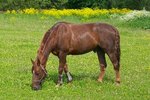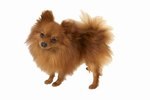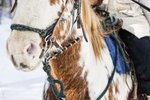
Dappling is the existence of irregular spots on an animal's skin. On horses, dapples are circles of slightly different shade than the rest of the coat. They're mysterious -- they can appear, disappear and then reappear at various stages in a horse’s life. Believe it or not, you may have a role in whether your horse’s coat gets dapples.
Dapple Grays
Many gray horses have dapples at some point in their lives. They are typically not born with this marking, and many times aren’t even born gray -- they can be born with any base color, often black but also chestnut or brown. They gray as they get older, gradually getting those circular dapples. But they are usually relatively short-lived. As the horse ages, the dapples fade, the hair whitens and the dapples disappear completely.
Other Dapple Coloring
Horses of other colors -- browns, chestnuts, blacks and bays -- don’t dapple predictably or intensely like dapple grays do, but some do have the genetic disposition for dapples to intermittently appear. Typically dapples appear after a horse sheds its winter coat growth. They can be difficult to see. Good grooming and health will accentuate them. If your horse is healthy and you groom him properly and regularly, but you still don’t see dapples, he doesn’t have the genes to produce them.
Nutrition
Some people believe the appearance of dapples on non-gray horses is an indication of good health. They’re not wrong, but they’re not entirely correct, either. Good nutrition is necessary for a healthy skin and coat, allowing dapples to appear in horses that are genetically disposed to them. In particular, your horse needs protein, a fat source, the trace minerals copper and zinc, and vitamin A for a healthy coat. Feeding your horse a diet of high-quality forage such as good pasture grass or hay that isn’t too old will give your horse most of these nutrients; a commercial grain will round it out.
Other Health Considerations
Another measure to promote skin and coat health, and to help bring out any dapples, is regular worming to shed your horse of parasites. When parasites invade your horse’s body, they rob him of the nutrients he needs. The result is a dull, lackluster coat. Often in such cases, a horse won’t be able to shed or will shed unevenly. Make sure he gets plenty of water and exercise. Both of these help deliver nutrients to his skin.
References
Resources
Photo Credits
-
Hemera Technologies/Photos.com/Getty Images
Writer Bio
Based in Central Texas, Karen S. Johnson is a marketing professional with more than 30 years' experience and specializes in business and equestrian topics. Her articles have appeared in several trade and business publications such as the Houston Chronicle. Johnson also co-authored a series of communications publications for the U.S. Agency for International Development. She holds a Bachelor of Science in speech from UT-Austin.




